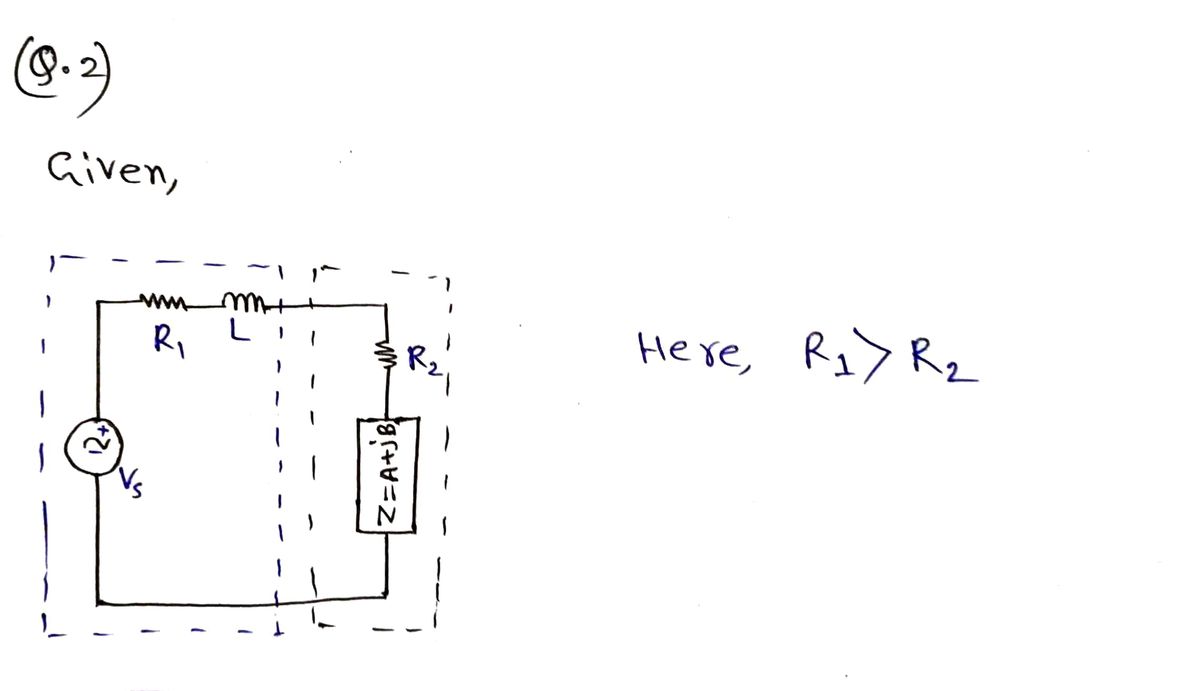Consider the circuit in Figure 2 with a source delivering power to a load consisting of Resistor R₂ (R₁>R₂) and unknown impedance Z. a) What component(s) would you insert in this circuit (in the place of Z) to result in the maximum power transfer to the load at a specific frequency 0. Express you result as function of the other component values in the circuit. b) With your added component(s) from part a), what fraction of the total power from the source will be delivered to the load? Source R1 L Load Z=A+jB Figure 2: Impedance Matching for Problem PL2
Consider the circuit in Figure 2 with a source delivering power to a load consisting of Resistor R₂ (R₁>R₂) and unknown impedance Z. a) What component(s) would you insert in this circuit (in the place of Z) to result in the maximum power transfer to the load at a specific frequency 0. Express you result as function of the other component values in the circuit. b) With your added component(s) from part a), what fraction of the total power from the source will be delivered to the load? Source R1 L Load Z=A+jB Figure 2: Impedance Matching for Problem PL2
Introductory Circuit Analysis (13th Edition)
13th Edition
ISBN:9780133923605
Author:Robert L. Boylestad
Publisher:Robert L. Boylestad
Chapter1: Introduction
Section: Chapter Questions
Problem 1P: Visit your local library (at school or home) and describe the extent to which it provides literature...
Related questions
Question

Transcribed Image Text:2) Consider the circuit in Figure 2 with a
source delivering power to a load consisting of Resistor R₂
(R₁>R₂) and unknown impedance Z.
a) What component(s) would you insert in this circuit (in
the place of Z) to result in the maximum power transfer to
the load at a specific frequency oo. Express you result as
function of the other component values in the circuit.
b) With your added component(s) from part a), what
fraction of the total power from the source will be
delivered to the load?
Source
R1 L
Load
Z=A+jB
R2
Figure 2: Impedance Matching for
Problem PL2
Expert Solution
Step 1

Step by step
Solved in 5 steps with 5 images

Knowledge Booster
Learn more about
Need a deep-dive on the concept behind this application? Look no further. Learn more about this topic, electrical-engineering and related others by exploring similar questions and additional content below.Recommended textbooks for you

Introductory Circuit Analysis (13th Edition)
Electrical Engineering
ISBN:
9780133923605
Author:
Robert L. Boylestad
Publisher:
PEARSON

Delmar's Standard Textbook Of Electricity
Electrical Engineering
ISBN:
9781337900348
Author:
Stephen L. Herman
Publisher:
Cengage Learning

Programmable Logic Controllers
Electrical Engineering
ISBN:
9780073373843
Author:
Frank D. Petruzella
Publisher:
McGraw-Hill Education

Introductory Circuit Analysis (13th Edition)
Electrical Engineering
ISBN:
9780133923605
Author:
Robert L. Boylestad
Publisher:
PEARSON

Delmar's Standard Textbook Of Electricity
Electrical Engineering
ISBN:
9781337900348
Author:
Stephen L. Herman
Publisher:
Cengage Learning

Programmable Logic Controllers
Electrical Engineering
ISBN:
9780073373843
Author:
Frank D. Petruzella
Publisher:
McGraw-Hill Education

Fundamentals of Electric Circuits
Electrical Engineering
ISBN:
9780078028229
Author:
Charles K Alexander, Matthew Sadiku
Publisher:
McGraw-Hill Education

Electric Circuits. (11th Edition)
Electrical Engineering
ISBN:
9780134746968
Author:
James W. Nilsson, Susan Riedel
Publisher:
PEARSON

Engineering Electromagnetics
Electrical Engineering
ISBN:
9780078028151
Author:
Hayt, William H. (william Hart), Jr, BUCK, John A.
Publisher:
Mcgraw-hill Education,